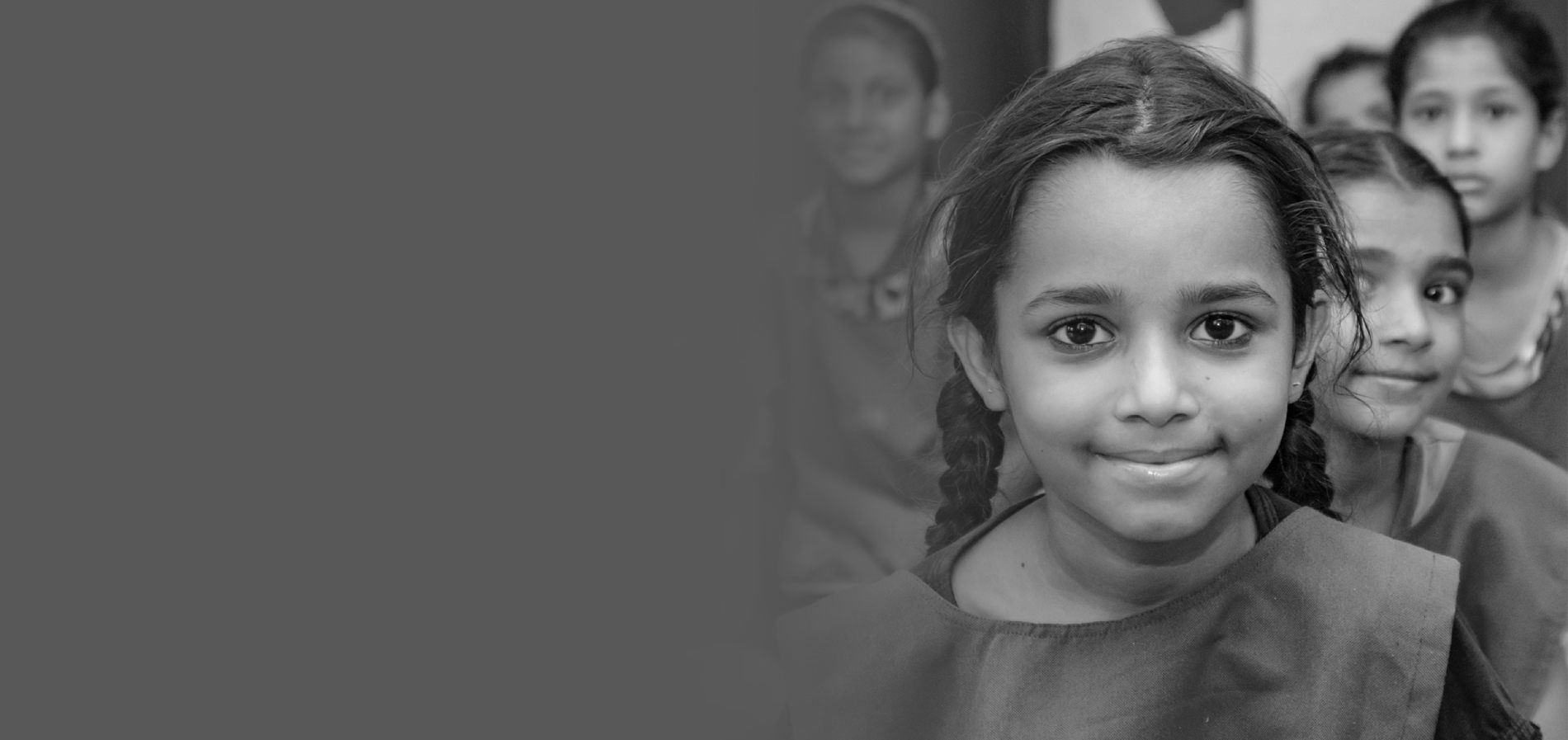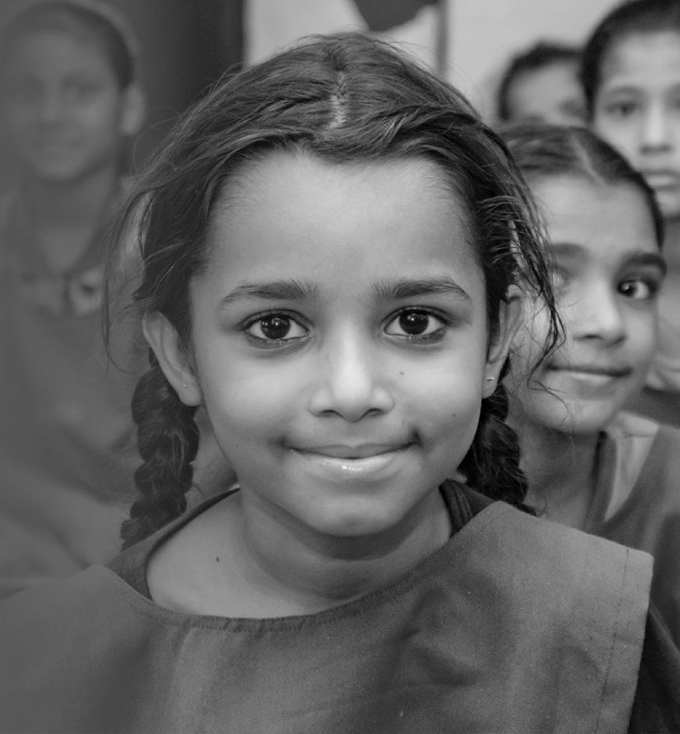About Us
KHUSHII (Kinship for Humanitarian Social and Holistic Intervention in India) is an independent, non-governmental organisation working for the upliftment and holistic development of underprivileged children, women and vulnerable families. Founded in December 2003 by Cricket legend Kapil Dev, KHUSHII is currently working in 12 states in India and reaching out to 50,000 students.
Through its flagship program ‘Shikshaantra Plus’, KHUSHII aims at a transformative learning cycle approach which would aim at school readiness, grade appropriate quality transitions, followed by integration of mental health components, life skills and digital education. This going forth, funnels into skill building towards future readiness for economic upliftment of students which also impacts the holistic portfolio of socio-economic positioning in the society.
The model looks at infrastructural augmentation, providing need-based human resource support, strengthening school governance, providing digital education support and skill building through the learning cycle approach.

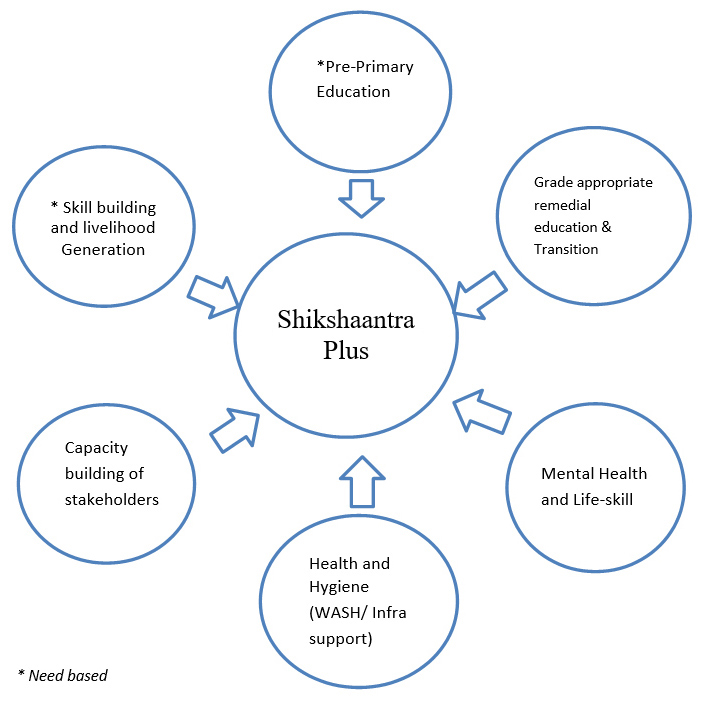
With KHUSHII’s intervention in Government Schools, we have witnessed:
• Increase in 80% student attendance and 75% in parental engagement
• 7% decrease in school dropout rate
• 2.1X improvement in overall result
• 60k+ children reached through mental health counselling
• 5100 sessions on key life-skill aspects
• 1.5L+ caregivers through Self Help Group (SHG) formation, and livelihood generation
• The pandemic has brought in a great divide in lesser-privileged children accessing education. Mapping this need, we aim to open 15 more schools by the end of this year, such that we can intervene in the following way:
• Augmenting infrastructure and/or repairing and building on any other essential requirement
• Catering to the fundamental needs of the children by providing them with RO systems and providing clean water to drink
• Making of computer and STEM labs
• Train the trainers on mental health and wellbeing
• Counselling session for beneficiaries
• Support Education in Maths, Science and English
• Offering the Higher Secondary students counselling on career options
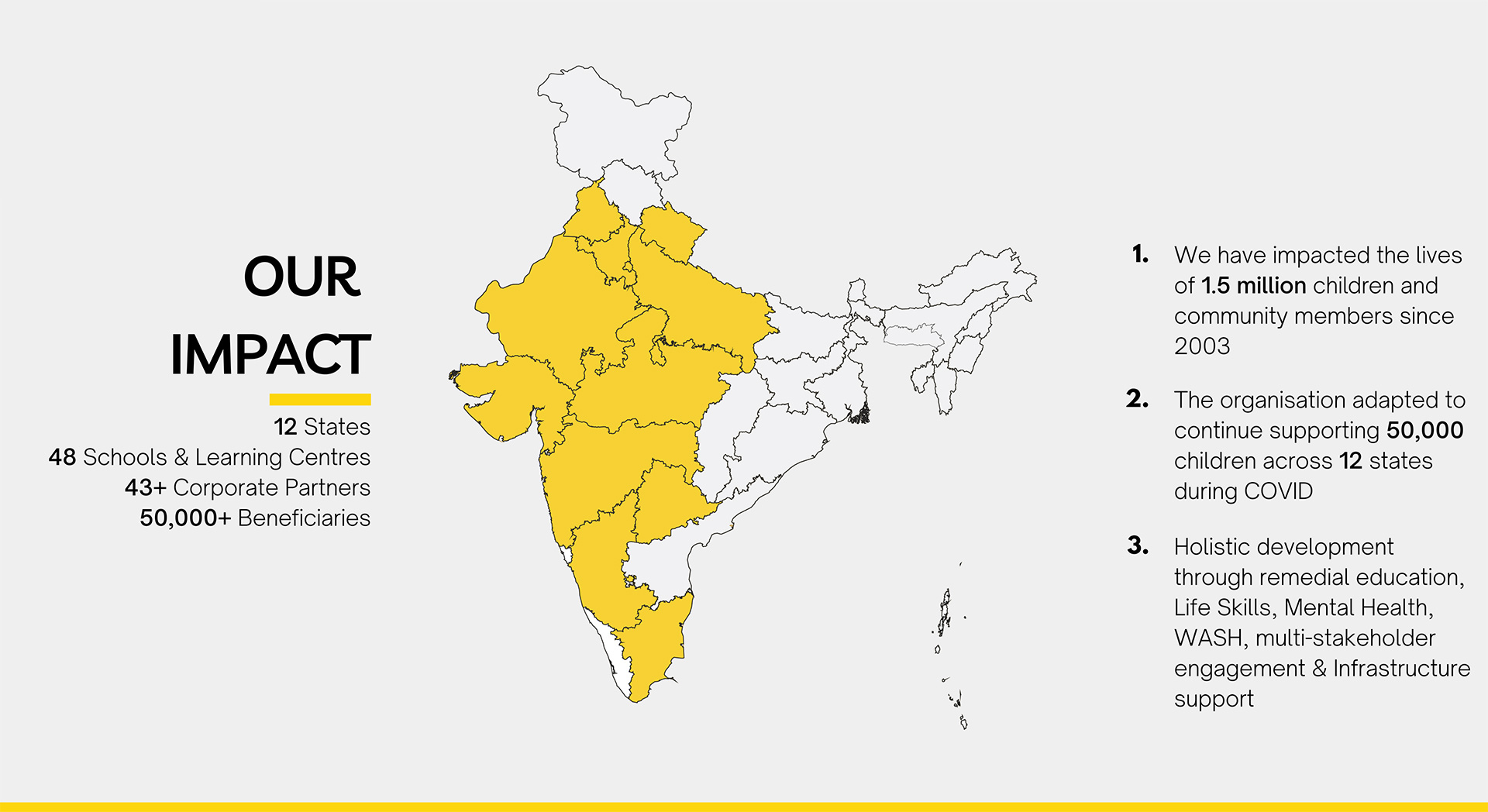
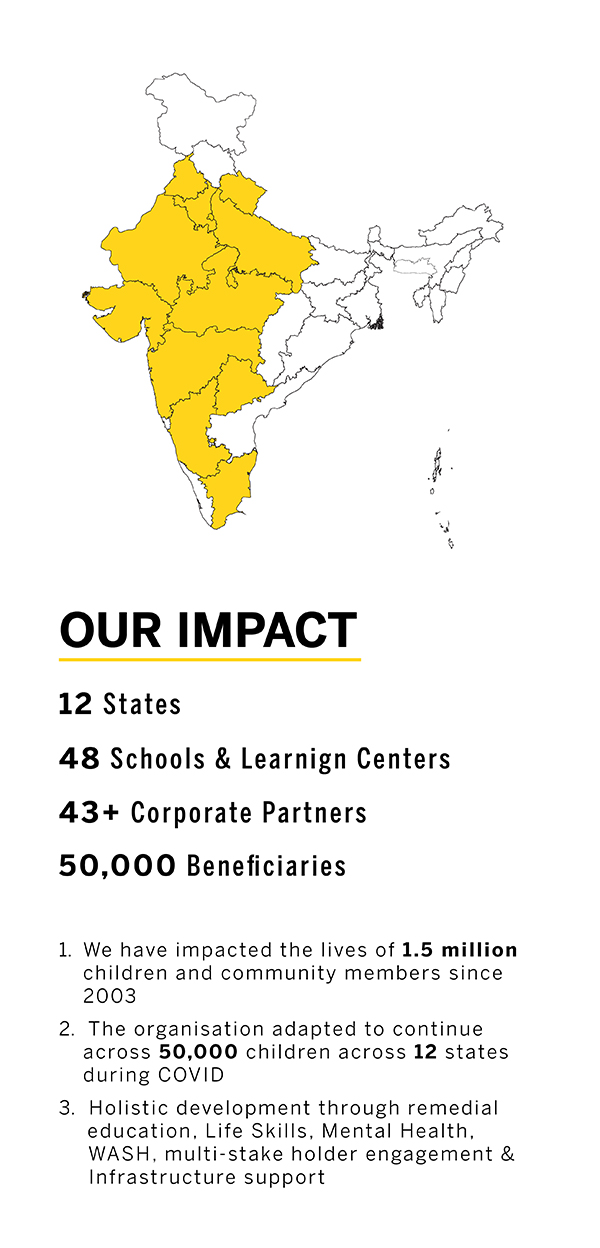
• Ensuring improved school readiness programme for children of 3 to 6 years of age so that they receive quality school readiness inputs through Integrated Child Development Services (ICDS) centres.
• Focusing on bridging the learning gaps through remedial education initiatives indicating a positive learning curve and ensuring reduction of irregularities/drop-outs through remedial education.
• Providing support education to children through support modules.
• Enhancing the quality of teachers by capacity building of stakeholders through capacity building modules.
• Ensuring mental wellbeing of students through direct outreach, caregivers/stakeholder sensitisation through a scientific approach by using standardised tools and techniques.
• Skill building of government school teachers on basic knowledge on the Mental Wellbeing of students to ensure that they are equipped with basic knowledge on the assessment of mental wellbeing of students and are able to navigate towards positive deviance on a case-to-case basis. (Need Based)
• Strengthening School governance by reforming school management committees as per norms of composition and nurturing sustainable strategies through effective school annual development planning and parental participation.
• Skill building of students through digital education. Ensuring that students have access to professional career guidance on digital domains for skill-based employability skills.
• Integrating life-skills support for value addition aiming towards better future readiness through components such as communication, spoken English, current affairs etc.
Result Indices
Shikshaantra Plus
| Goal | Improving learning levels of students through better retention, mental well-being, ensuring strong school governance and enhancing skills of students for future readiness through digital literacy, skill building, and livelihood strengthening programme and life skills |
| Expected Impact | All Students in the intervention area reach ideal learning levels and attain ideal mental well-being and acquire future readiness skills for employability and future readiness. |
| Objective | Outcome Indicators | Inputs/Activities | Output Indicators | Target |
| Improve school Readiness programme (ECE) | Children in 3-6 years receive quality school readiness inputs through ICDS centres | Training of ICDS workers on ECE module as per the standard framework | No. of ICDS workers trained on ECE and no. of children covered under these centres. | 20 ICDS workers
and 1 ICDS Supervisor. 100% children in 3-6 years catered under the programme. |
| Creating a module on new ways of teaching through play integrated method | Module developed and no. of ICDS workers trained on it. .No. of students covered under the module | 20 ICDS workers
and 1 ICDS Supervisor. 100% children in 3-6 years catered under the programme. |
||
| Development of worksheets (practice content for children) | Worksheets developed and no. of worksheets distributed to the children per month. Timely completion of workbooks by the children. | 150 - 200 children in 10 ICDS centres |
||
| Strengthening mothers’ committee to ensure positive psychosocial development of their children | No. of meetings/trainings organized for the mothers No. of mothers attending the meetings/training | 150 - 200 mothers |
||
| Bridging Learning Gaps | Ensuring grade and subject-wise positive learning curve | Identification of students seeking remedial support | No. of children covered under remedial and support initiatives. | 100% students 8-10% students getting mainstreamed |
| Reducing irregularities / drop-o uts through remedial education | Intervention through Art Integrated Learning, Digital classes, customized curriculum, worksheets and different teaching techniques | % decrease in dropouts and irregularity. % Increase of grade wise enrolment |
3-5 % decrease in year 1 | |
| Tracking of children and taking learning assessments of students | No. of students tracked on grade appropriate learning Trend of subject/grade wise LO’s | 100% students | ||
| Support Education to Students | No. of students covered through support module | Identification of students seeking support education | No. of students identified for support education sequential al Increase PA per grade | 100% Students identified |
| Tracking of children and taking learning assessments of children | No. of students promoted to next grade trend of Pre - Mid Assessments & Progression. | 5 to 8% improvement in grades per year | ||
| Enhancing quality of teaching through capacity building of stakeholders | No. of teachers covered through capacity -building modules | Training of Teachers (ToT) - Learning Outcomes & TLM Usage | No. of teachers trained on learning
outcomes assessment. No. of TOTs organised for Govt School teachers. Present % of teachers. No. of individual development plans/CCE forms in place for students. Online Feedback of Parents (if available) on virtual platforms/digital database. |
All Teachers hired for the program 2 ToTs per school 65 to 70% present percentage |
| ToT - Water Sanitation & Hygiene | No. of WASH sessions conducted Qualitative progression on WASH practices Qualitative / Observ atory opinion on WASH practices in place | 4 Health & Hygiene Camps per year and 4 WASH sessions At least 75 to 80 % of students can recall | ||
| CCT (Creative & Critical Thinking) | No. of sessions with students per year. No. Of students engaged in CCT modules |
100% Selected students | ||
| Value Based/Soft Skills Sessions taken up | No. of sessions in a year with all the students enrolled. Life Skills topics for each month | 12 sessions in a year with all the students enrolled | ||
| Ensuring Mental Well-being of students | No. of students and parents covered on mental health | Identification / Mapping of mental well being status of students (WHO - 5, SDQ, DSM Cross Cutting) | No. of Children mapped and categorised under formal mental well-being categories. No. Of Children catered for grade improvisation on mental well-being. | 100%. Improvisation At Least 20% |
| TOT’s conducted for parents/teachers | No. of TOT’s conducted & participants covered. Topics covered under the modules | Monthly | ||
| Skill building of government school teachers on basic knowledge on mental wellbeing of students
*Need Based Component |
Government school teachers are equipped with basic knowledge on assessment of mental well-being of students and are able to navigate towards positive deviance on a case-to-case basis | Understanding student mental health and development needs Strategies to make the classroom safe and developing relationships with students. SEL (Social emotional learning) Understanding and addressing stigma i the classroom. | No. of government teachers covered. One session per week. | 100% of Teachers in selected schools |
| Training on life skills | Interventions designed according to the need of students for the social, emotional, cognitive, behavioural development of students. No. Of students covered under | 100% Students | ||
| life skill activities. | ||||
| Strengthening school Governance | School management committee reformed as per norms & composition | Coordinating in conducting SMC meetings based on particular agendas | School Management Committees hold regular meetings | As per norms |
| No. of Resolutions taken-up | 25% Identified | |||
| No. of resolutions acted upon and state resources mobilised | At Least 25% | |||
| Participation of Maitre e Group (student collectives) | No. of meetings in a year No. of students members of the group No. Of activities conducted along with topics covered | 10 meetings in a year 50 to 60 students to be members of the group | ||
| Conducting PTMs as per the standard frequency | No. of PTMs in a year % Increase in attendance and participation of Parents during PTM, Regularity of students’ progress | 6 PTMs in a year 5 to 10 % Increase in attendance and participation of parents during PTM in year 1 | ||
| Skill Building through Digital Education for future ready | Imparting career guidance and skills on digital domains for preparedness | No. of students covered through skill building and career guidance sessions. | 70-80% Students attendance | |
| Extending digital skill- building trainings to students | No. of students covered under specific modules for future readiness and higher education. | All students identified. | ||
| Entrepreneurship development amongst youth and women for economic empowerment | Enhanced disposable individual income by at least 50% | No. of beneficiaries attained enhanced income level | 50% beneficiaries identified | |
| Formation of (Self-Help Groups) SHG’s | No. Of SHG’s formed and No. Of beneficiaries covered (*Need Based as per baseline assessment) | |||
| No. of SHG’s/Youth collectives linked to thrift & credit facilities | NABARD/National Livelihood Mission |
| Objective | Improve school Readiness programme (ECE) |
| Outcome Indicators | Children in 3-6 years receive quality school readiness inputs through ICDS centres |
| Inputs/Activities | Training of ICDS workers on ECE module as per the standard framework |
| Output Indicators | No. of ICDS workers trained on ECE and no. of children covered under these centres. |
| Target | 20 ICDS workers
and 1 ICDS Supervisor. 100% children in 3-6 years catered under the programme. |
| Objective | |
| Outcome Indicators | |
| Inputs/Activities | Creating a module on new ways of teaching through play integrated method |
| Output Indicators | Module developed and no. of ICDS workers trained on it. .No. of students covered under the module |
| Target | 20 ICDS workers
and 1 ICDS Supervisor. 100% children in 3-6 years catered under the programme. |
| Objective | |
| Outcome Indicators | |
| Inputs/Activities | Development of worksheets (practice content for children) |
| Output Indicators | Worksheets developed and no. of worksheets distributed to the children per month. Timely completion of workbooks by the children. |
| Target | 150 - 200 children in 10 ICDS centres |
| Objective | |
| Outcome Indicators | |
| Inputs/Activities | Strengthening mothers’ committee to ensure positive psychosocial development of their children |
| Output Indicators | No. of meetings/trainings organized for the mothers No. of mothers attending the meetings/training |
| Target | 150 - 200 mothers |
| Objective | Bridging Learning Gaps |
| Outcome Indicators | Ensuring grade and subject-wise positive learning curve |
| Inputs/Activities | Identification of students seeking remedial support |
| Output Indicators | No. of children covered under remedial and support initiatives. |
| Target | 100% students 8-10% students getting mainstreamed |
| Objective | |
| Outcome Indicators | Reducing irregularities / drop-o uts through remedial education |
| Inputs/Activities | Intervention through Art Integrated Learning, Digital classes, customized curriculum, worksheets and different teaching techniques |
| Output Indicators | % decrease in dropouts and irregularity. % Increase of grade wise enrolment |
| Target | 3-5 % decrease in year 1 |
| Objective | |
| Outcome Indicators | |
| Inputs/Activities | Tracking of children and taking learning assessments of students |
| Output Indicators | No. of students tracked on grade appropriate learning Trend of subject/grade wise LO’s |
| Target | 100% students |
| Objective | Support Education to Students |
| Outcome Indicators | No. of students covered through support module |
| Inputs/Activities | Identification of students seeking support education |
| Output Indicators | No. of students identified for support education sequential al Increase PA per grade |
| Target | 100% Students identified |
| Objective | |
| Outcome Indicators | |
| Inputs/Activities | Tracking of children and taking learning assessments of children |
| Output Indicators | No. of students promoted to next grade trend of Pre - Mid Assessments & Progression. |
| Target | 5 to 8% improvement in grades per year |
| Objective | Enhancing quality of teaching through capacity building of stakeholders |
| Outcome Indicators | No. of teachers covered through capacity -building modules |
| Inputs/Activities | Training of Teachers (ToT) - Learning Outcomes & TLM Usage |
| Output Indicators | No. of teachers trained on learning
outcomes assessment. No. of TOTs organised for Govt School teachers. Present % of teachers. No. of individual development plans/CCE forms in place for students. Online Feedback of Parents (if available) on virtual platforms/digital database. |
| Target | All Teachers hired for the program 2 ToTs per school 65 to 70% present percentage |
| Objective | |
| Outcome Indicators | |
| Inputs/Activities | ToT - Water Sanitation & Hygiene |
| Output Indicators | No. of WASH sessions conducted Qualitative progression on WASH practices Qualitative / Observ atory opinion on WASH practices in place |
| Target | 4 Health & Hygiene Camps per year and 4 WASH sessions At least 75 to 80 % of students can recall |
| Objective | |
| Outcome Indicators | |
| Inputs/Activities | CCT (Creative & Critical Thinking) |
| Output Indicators | No. of sessions with students per year. No. Of students engaged in CCT modules |
| Target | 100% Selected students |
| Objective | |
| Outcome Indicators | |
| Inputs/Activities | Value Based/Soft Skills Sessions taken up |
| Output Indicators | No. of sessions in a year with all the students enrolled. Life Skills topics for each month |
| Target | 12 sessions in a year with all the students enrolled |
| Objective | Ensuring Mental Well-being of students |
| Outcome Indicators | No. of students and parents covered on mental health |
| Inputs/Activities | Identification / Mapping of mental well being status of students (WHO - 5, SDQ, DSM Cross Cutting) |
| Output Indicators | No. of Children mapped and categorised under formal mental well-being categories. No. Of Children catered for grade improvisation on mental well-being. |
| Target | 100%. Improvisation At Least 20% |
| Objective | |
| Outcome Indicators | |
| Inputs/Activities | TOT’s conducted for parents/teachers |
| Output Indicators | No. of TOT’s conducted & participants covered. Topics covered under the modules |
| Target | Monthly |
| Objective | Skill building of government school teachers on basic knowledge on mental wellbeing of students
*Need Based Component |
| Outcome Indicators | Government school teachers are equipped with basic knowledge on assessment of mental well-being of students and are able to navigate towards positive deviance on a case-to-case basis |
| Inputs/Activities | Understanding student mental health and development needs Strategies to make the classroom safe and developing relationships with students. SEL (Social emotional learning) Understanding and addressing stigma i the classroom. |
| Output Indicators | No. of government teachers covered. One session per week. |
| Target | 100% of Teachers in selected schools |
| Objective | |
| Outcome Indicators | |
| Inputs/Activities | Training on life skills |
| Output Indicators | Interventions designed according to the need of students for the social, emotional, cognitive, behavioural development of students. No. Of students covered under |
| Target | 100% Students |
| Objective | |
| Outcome Indicators | |
| Inputs/Activities | |
| Output Indicators | life skill activities. |
| Target | |
| Objective | Strengthening school Governance |
| Outcome Indicators | School management committee reformed as per norms & composition |
| Inputs/Activities | Coordinating in conducting SMC meetings based on particular agendas |
| Output Indicators | School Management Committees hold regular meetings |
| Target | As per norms |
| Objective | |
| Outcome Indicators | |
| Inputs/Activities | |
| Output Indicators | No. of Resolutions taken-up |
| Target | 25% Identified |
| Objective | |
| Outcome Indicators | |
| Inputs/Activities | |
| Output Indicators | No. of resolutions acted upon and state resources mobilised |
| Target | At Least 25% |
| Objective | |
| Outcome Indicators | |
| Inputs/Activities | Participation of Maitre e Group (student collectives) |
| Output Indicators | No. of meetings in a year No. of students members of the group No. Of activities conducted along with topics covered |
| Target | 10 meetings in a year 50 to 60 students to be members of the group |
| Objective | |
| Outcome Indicators | |
| Inputs/Activities | Conducting PTMs as per the standard frequency |
| Output Indicators | No. of PTMs in a year % Increase in attendance and participation of Parents during PTM, Regularity of students’ progress |
| Target | 6 PTMs in a year 5 to 10 % Increase in attendance and participation of parents during PTM in year 1 |
| Objective | Skill Building through Digital Education for future ready |
| Outcome Indicators | |
| Inputs/Activities | Imparting career guidance and skills on digital domains for preparedness |
| Output Indicators | No. of students covered through skill building and career guidance sessions. |
| Target | 70-80% Students attendance |
| Objective | |
| Outcome Indicators | |
| Inputs/Activities | Extending digital skill- building trainings to students |
| Output Indicators | No. of students covered under specific modules for future readiness and higher education. |
| Target | All students identified. |
| Objective | Entrepreneurship development amongst youth and women for economic empowerment |
| Outcome Indicators | |
| Inputs/Activities | Enhanced disposable individual income by at least 50% |
| Output Indicators | No. of beneficiaries attained enhanced income level |
| Target | 50% beneficiaries identified |
| Objective | |
| Outcome Indicators | |
| Inputs/Activities | |
| Output Indicators | Formation of (Self-Help Groups) SHG’s |
| Target | No. Of SHG’s formed and No. Of beneficiaries covered (*Need Based as per baseline assessment) |
| Objective | |
| Outcome Indicators | |
| Inputs/Activities | |
| Output Indicators | No. of SHG’s/Youth collectives linked to thrift & credit facilities |
| Target | NABARD/National Livelihood Mission |
EXPANSION PLAN
The names of our schools that we are starting intervention in, are as follows: (SP = Shikshaantra Plus; AIP = Adapt Impact Programme):
• New Delhi 5, looking to expand to 3 in L-Block, K-2, Swatantra Shikshaantra
• Haryana 5 SPs
• 2 centres in Karnataka, 4 AIPs, want to expand to 2 more in Thanisandra & Hebbagodi
• Maharashtra 4 SPs, 2 AIPs, want to expand to 4 – Thane, Chembur, Jogeshwari, Powai
• Telengana 1 SP, 1 AIP; identified for expansion 7 in Sikanderabad, Ramagundam,Vemulawada, Godawari Khani, Jayyram, Vital Nagar, Santosh Nagar
• 2 SPs in TN at Kancheepuram, and wish to extend to 2 more in Padappai and
• Nandambakkam
• 2 SPs in Alwar (Bhiwadi), Rajasthan
• 1 SP in Ludhiana in Punjab
• 2 SPs in Ahmedabad, Gujarat
• 4 SPs in up (3 in Gautam Buddh Nagar, 1 in Varanasi), expansion to 5 in Lahurabir, Maldhaiy, Ramnagar, Jakhni
• SPs in Uttarakhand (Ramgarh and Mukteshwar, and wish to expand to 5 more in Pouri Garwhal)
Total SPs: 36
AIPs: 11
Expansion Plan under Indiaspora: 28
31 schools for Manobal: Training of Govt teachers
Community based intervention in Sangam Vihar under Early Child Education (ECE): Sangam Vihar Anganwadi Centres 10

